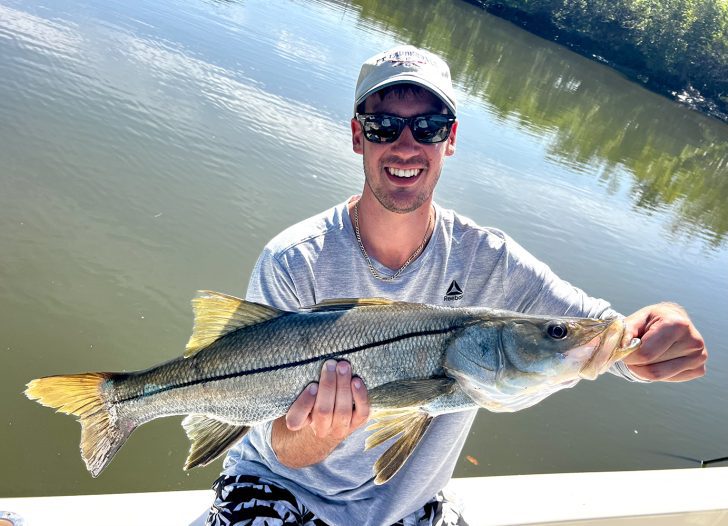Inshore Slam Fishing in Tampa Bay
Targeting snook, redfish and seatrout.
Tampa Bay is renowned for its fantastic fishing opportunities. Inshore slam fishing, which involves catching snook, redfish and seatrout in a single trip, is one of the most sought-after challenges for anglers in this area. The Bay’s diverse ecosystem and abundance of these fish species make it an ideal destination for both amateur and experienced fishermen.
Snook are prized for their aggressive strikes and impressive fighting abilities. They are found throughout Tampa Bay, especially near mangroves, docks and seawalls. Snook can be caught year-round, but they are most active from spring to early fall. Snook prefer warmer waters and are often found in areas with good tidal flow.
Redfish, also known as red drum, are another popular target for inshore anglers. Redfish are known for their powerful runs and can be found in a variety of habitats, including grass flats, oyster beds and mangrove shorelines. Redfish are typically caught using live bait or artificial lures.
Seatrout, or spotted seatrout, are abundant in Tampa Bay, especially in grassy areas and over sandy bottoms. Seatrout are known for their delicate flesh and are often targeted by anglers looking to catch their limit quickly. Seatrout are most commonly caught using scaled sardines, live shrimp or soft plastic lures.
Fishing Techniques:
Using live bait is one of the most effective ways to catch snook, redfish and seatrout in Tampa Bay. Common live baits include scaled sardines, live shrimp and pinfish. Anglers typically use a light tackle setup with a 2/0 hook and 25 to 30-pound fluorocarbon leader to avoid spooking the fish. Free-lining live bait or using a popping cork can attract these species and entice them to strike.
Artificial lures are also a popular choice for targeting these inshore species. Soft plastic lures, topwater plugs and spoons can mimic the movement of baitfish and attract strikes from snook, redfish and seatrout. Using a slow and steady retrieve or a twitching motion can be effective in enticing these fish to bite.
For those looking for a more challenging and rewarding experience, fly fishing in Tampa Bay can be an excellent option. Using flies that imitate baitfish, shrimp and crabs can be very effective for catching snook, redfish and seatrout. Fly anglers should focus on sight fishing in shallow waters and presenting their flies accurately to avoid spooking the fish.
Popular Locations:
Weedon Island Preserve is known for its diverse habitats, including mangroves, grass flats and oyster beds. The preserve’s shallow waters and abundant baitfish make it a prime location for inshore slam fishing.
Fort De Soto Park is another hotspot for inshore fishing in Tampa Bay. Its mix of sandy beaches, grass flats and deep channels attracts snook, redfish and seatrout. The park’s accessibility and variety of fishing spots make it a favorite among local anglers.
The upper portion of Tampa Bay, including Old Tampa Bay and Hillsborough Bay, is known for its productive fishing grounds. The area’s tidal creeks and mangrove shorelines provide excellent habitat for snook, redfish and seatrout. This region is ideal for anglers looking to explore less crowded fishing spots.
Conservation and Regulations:
To ensure the sustainability of these prized fish species, anglers should be aware of local fishing regulations and practice conservation-minded fishing. Tampa Bay has specific rules regarding size limits, bag limits and seasonal closures for snook, redfish and seatrout. It is important to follow these regulations and practice catch-and-release whenever possible to protect the fish populations for future generations.
Inshore slam fishing in Tampa Bay for snook, redfish and seatrout offers an exhilarating experience for anglers of all skill levels. With its diverse habitats, abundant fish populations and stunning scenery, Tampa Bay is a prime destination for those looking to achieve the coveted inshore slam. By understanding these species, using effective techniques and respecting conservation rules, anglers can enjoy sustainable fishing for years to come.
Afishionado, “Adventures in Fishing.”

